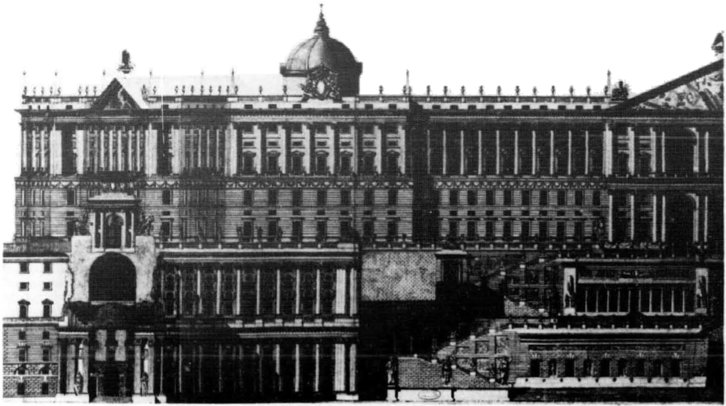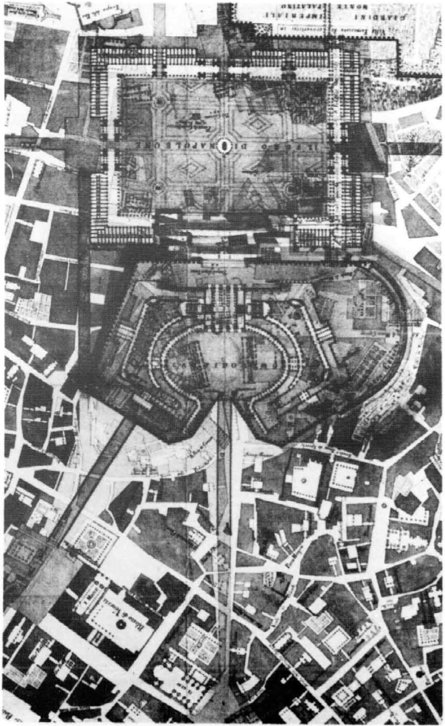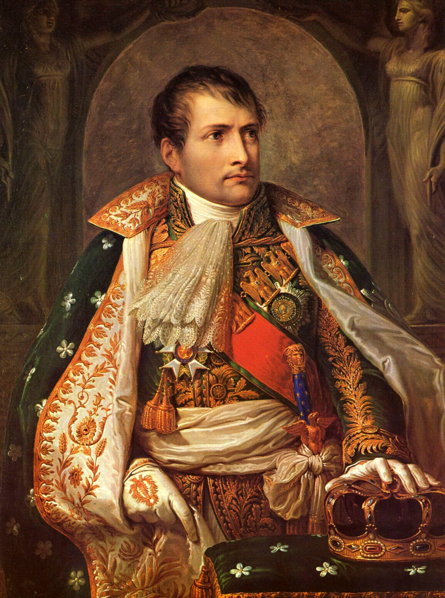
About Andrew Cusack
 Writer, web designer, etc.; born in New York; educated in Argentina, Scotland, and South Africa; now based in London.
Writer, web designer, etc.; born in New York; educated in Argentina, Scotland, and South Africa; now based in London. read more
News
Blogs
Reviews & Periodicals
Arts & Design
World
France
Mitteleuropa
Knickerbockers
Argentina
The Levant
Africa
Cape of Good Hope
Netherlands
Scandinavia
Québec
India
Muscovy
Germany
Academica

Scipione Perosini’s Imperial Palace
An ambitious Italian’s mad plan to bulldoze the Roman Forum, destroy Michaelangelo’s Piazza del Campidoglio, and build a Napoleonic palace atop the Capitoline Hill.
 Some architectural projects are just so completely mental and insane that you actually have to doff your cap to the creativity of their inventors. Scipione Perosini’s ‘Projet d’un palais impérial à Rome’ is one such plan.
Some architectural projects are just so completely mental and insane that you actually have to doff your cap to the creativity of their inventors. Scipione Perosini’s ‘Projet d’un palais impérial à Rome’ is one such plan.
In the 1800s, with Napoleon the master of Europe, prominent citizens of various Italian cities submitted plans for the architectural aggrandisement of their communities under the beneficent patronage of the revolutionary monarch. In Rome, the architect and hydraulic engineer Scipione Perosini drafted his project for a imperial Napoleonic megapalace.
Atop the Capitoline, Michaelangelo’s Piazza del Campidolgio would be destroyed except for the Palazzo dei Senatori, which would be the central focus of a massive neo-classical palace encompassing the entire Capitoline Hill. From the Hill, a series of terraces would cascade down to the Roman Forum, which would be demolished and paved over to form a new ‘Foro di Napoleone’ celebrating the emperor. Across the Forum, on the Palatine, a new imperial residence circled by gardens would house Napoleon, who proclaimed himself King of Italy, during his prospective stays in the second capital of his empire.
Besides the imperial residence, Perosini’s megalomaniacal scheme would include offices for twenty ministries, a court of appeals, a prefecture, the customs bureaucracy, barracks for the Imperial Guard, and plenary chambers for the constitutional assemblies.
David Watkin, in his history of the Roman Forum, notes the palace “was to incorporate the Palazzo Venezia as its administrative wing, the historic church of S. Maria Aracoeli on the Capitol as its chapel, and the Forum as its inner courtyard”.

Napoleon in his portrait as King of Italy
As Terry Kirk notes (in the informative The Architecture of Modern Italy, Volume I, The Challenge of Tradition: 1750-1900), in the Imperial Palace “facets of ancient, medieval, and Renaissance Rome were reconstructed in a gargantuan field of columns and halls stretching across the Forum Romanum to the Colosseum.”
But Kirk also points out of Perosini that “his proposal was far too grand to ever be taken seriously”. One historian described it as “ludicrously ambitious and costly”; another as “impossibly grandiose and destructive”. One is astounded by the sheer bravado to conceive of destroying forever the remaining ruins of the Roman Forum, though one should point out the Forum at that time was much less excavated, and thus much less apparent in how much of it was actually left.
“It was far too expensive to build,” Susan Vandiver Nicassio points out (in Imperial City: Rome under Napoleon), “and it would have required a destruction of ancient monuments that would have outdone the barbarians.”
Born Napoleone di Buonaparte in a moderately successful Italian family of untitled nobility on Corsica, Napoleon was, at the hight of his power, “By the Grace of God and the Constitutions of the Republic, Emperor of the French, King of Italy, Protector of the Confederation of the Rhine, Mediator of the Helvetic Confederation”.
“In 1811,” Nicassio continues, “a multi-century, multi-continental rule of the House of Bonaparte seemed entirely possible; within two years the Napoleonic rule in Europe had begun to crumble, and before 1815 it was gone.”
It is obvious that Perosini’s project — thank God — never had a chance of becoming reality. It would have been one of the greatest acts of cultural desecration Europe has witnessed, but despite the rapacious destruction it would wreak and the chauvinist arrogance of its spirit, I can’t help but almost admire his scheme. As Nicassio avers, “it was a dream worthy of the new great Caesar.”
And very well: just so long as it remains on the drawing board.

Search
Instagram: @andcusack
Click here for my Instagram photos.Most Recent Posts
- Burns Tower April 19, 2024
- Patrick in Parliament March 18, 2024
- Articles of Note: 13 March 2024 March 13, 2024
- Cambridge March 9, 2024
- Taken on Trust March 4, 2024
Most Recent Comments
Book Wishlist
Monthly Archives
Categories



“Projet d’un palais impérial”. Not “impériale”. But interesting article.
Reminds one of another dictator’s grandiose plans for a city much further North: had it come to fruition a good part of 19th century Berlin would have disappeared, but somehow one does not feel that the sacrifice would have been quite so disastrous, either architecturally or historically.
Did Perosini leave anything of significance behind?
Mr. Cusack,
what are your thoughts, then, on Perosini’s influence on the master plan of Rome prepared by Giovannoni, Brasini and Piacentini in 1931? If there was such an influence in the first place …